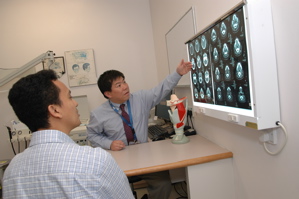Diagnosis
An examination of the larynx typically reveals the lesion, and a biopsy, performed under general anaesthesia, confirms the diagnosis. Staging of the cancer involves examining the tumour's extent during the biopsy as well as by through imaging techniques.
Glottic tumours are often detected at an early stage due to voice changes caused by even the small tumour growths on the vocal cords. In comparison, supraglottic cancers are generally more advanced when detected.
Treatment options
The treatment of laryngeal cancer depends on both the location and the stage of the disease. Early-stage cancers may be addressed with radiation therapy or surgery, including laser operations.
For advanced laryngeal cancer, a combination of chemotherapy and radiation is commonly prescribed. Patients presenting with lymph node enlargement in the neck, appearing as neck lumps, may achieve favourable outcomes through minimally invasive surgery to preserve voice or by radiation therapy. Similarly, advanced tumours may also respond well to surgery combined with radiation and/or chemotherapy.
Historically, radiation, with or without chemotherapy, has been the standard treatment for these tumours, aiming to cure while preserving the vital functions of speech and swallowing.
Radiation therapy has proven effective for early-stage laryngeal cancers, with 5-year survival rates exceeding 80% for Stage I and II when this treatment is employed. Voice quality generally remains satisfactory, and swallowing function is typically unaffected.
The side effects of radiation can include oral dryness and painful ulcers that interfere with eating and drinking. However, with newer techniques, such as intensity-modulated radiation therapy (IMRT), have reduced these side effects. Recurrences are generally managed by surgery rather than with a second course of radiation.
Trans-oral laser resection is another treatment for early-state laryngeal cancers. The tumour is accessed and removed via a laryngoscope, avoiding external incisions, and excised with a carbon dioxide laser.
This modality is particularly beneficial for small vocal cord lesions. Patients often require no more than a two-day hospital stay. Although the voice may initially be weak, it tends to recover quickly and remain clear. Swallowing can often be resumed the day after surgery, and tracheostomy is typically unnecessary.
The success rates for this method are comparable to those of radiation, with patients usually returning to work within two to three weeks.
Trans-oral laser resection may not be suitable for every patient with early laryngeal cancer. For those with an anteriorly positioned larynx or tumours extending beyond the larynx, this method may not be suitable. The quality of voice post-treatment can vary, generally correlating with the volume of tissue removed.


















